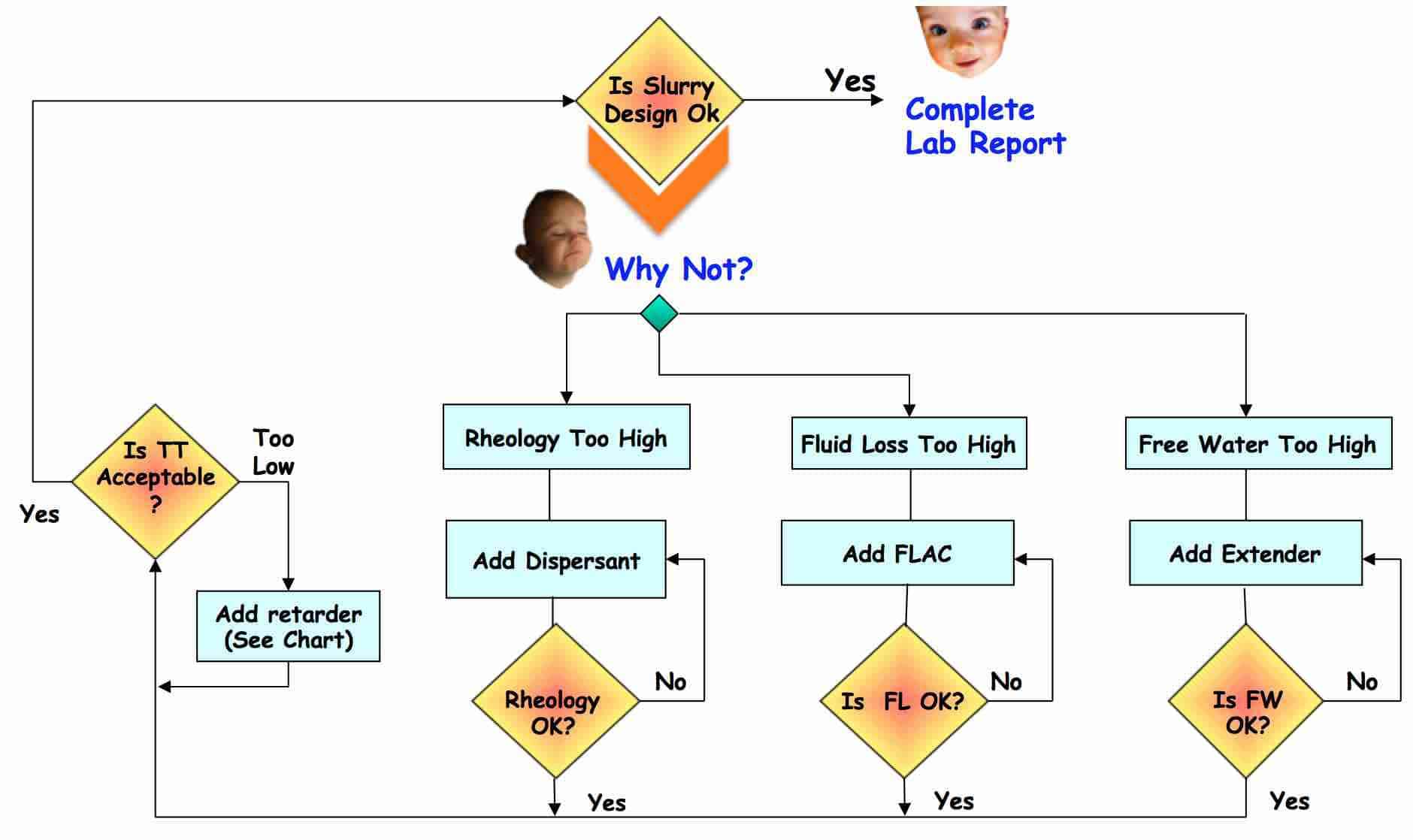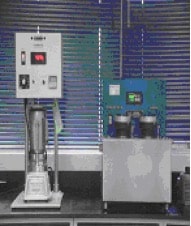The optimal cement slurry mix design principle
There is one principle that I have learnt to always keep in mind when talking about designing a cement mix slurry. This principle is easy to remember: ‘the simpler, the better.’
In this context, this means using the lowest amount of additives as is reasonable, and using them in their lowest effective concentration that can still provide the desired cement slurry features.
We base the principle on the assumption that there is a level of interaction* between all the components in a cement slurry. So, by reducing the number of elements and their concentration, the side effects would be minimized.
However, sometimes this is not that easy. The cement slurry mix design formulation would strongly depend on the experience of the laboratory itself (database) and the lab technician.
The flowchart below is a simple point of departure to design conventional cement slurry systems for each well-cementing laboratory.
Depending on workload, experience, availability of quality cement and chemicals, this cement slurry design flowchart is adapted to ensure that we can deploy reliable fluid systems.
(*) Interaction = the balance between desired (targeted) and negative (side effects) reactions.

What steps do you take to make corrections in the following cases?
Please share in the comments section below your solutions for when:
- Rheology is too low
- You have gelation problems
- There are compatibility issues with the mud
- The static gel strength is too low (45 min)
- The compressive strength development is too slow or the max. value is too low
BONUS: Visible Vortex @ 12000 rpm (blender) = Good surface mixability
Cheers
L. Diaz



Yes, you are right, some time cement slurry design might be more than just the flow chart above, due to the function and properties of some chemical. Some fluid loss chemical has dual function some time tri-function, In optimizing the additive, the flow chart above will be greatly altered.
Rheology too Low
For low rheology, anti-settling agent or gelling additive / some fluid loss additive that has the ability to add viscosity to the fluid need to be used, however, you must strick a balance in optimizing the concentrations, since most of this additive have some negative impact on compressive strength
Gelation problems,
This occurs when the amount of dispersant or other chemicals like fluid loss are either too much or too little. The main challenge is to optimize the chemicals.
Compatibility Issues (with the mud)
Compatibility measurement is still a subjective issue, that relies mostly on personal judgment than values obtained in rheological figures. However, the values are fundamentals to engineers.
Compressive strength Development (too slow) or Max. value (too low)
Many a times slurry are design with too many concentrations of additive than expected. some additive like gelling agent that increase viscosity and improve the rheological properties tend to reduce compressive strenght or delay Cs, again proper optimization is the key to a better cement design. the same principle applies to SGS, so optimization is the key.
Hi Valentine. Great contribution to the topic, certainly very useful to our readers.
Agree with you Lenin a very valuable input from Valentine, also an absolute necessity of running the lab tests with the water and cement samples received from the rig prior to the job.
What I usually do is ask for tests to be ran at the beginning of the project (DWOP) and when I accepted slurry characteristics for each casing job plus a possible plug for every section, final recipe to be fine tuned with the rig samples to take into account any adjustment that may be needed because of possible alterations of the bulks and additives.
Better safe than sorry!
Eric, thanks for this comment, this is experience talking, but also a very nice way to keep all involved in line with the planning. Not only the people in the DWOP, but the rest of the organization, supply chain, inventory, laboratory.
Review the CHL Web Page http://www.chllogs.com or google Oil Well Cement Evaluation and select the CHL.
To add the CHL to the Cement Slurry Design Decision Tree with a playback of the CHL Trace and CHL Heading for a Well you are working on, send a pdf file of the main log section, a LAS file with the 3 FT Amplitude and Depth data, the Casing Size, Weight, and the Weight of the Cement. Plus the Well Sketch Data – Well Depth, Casing Depth, Float Collar Depth, and Mud Weight.
Working together, the CHL could provide In Place Cement Placement and the Cement Placement Patterns, with Measured In Place Cement Curing at the time the Log was run, and provide an additional Visual, Simple, Consistent Cement Evaluation Presentation for the Cement Slurry Design Decision Tree.
Looking forward to your reply.
Bill Wheelis
Phone – 1 – 504 – 393 – 0263
Bill, thanks for your contribution. I have seen the website http://www.chllogs.com and I am quite interested. I will send you a message to the email address you provided to discuss further.
L. Diaz
Hello Lenin, thanks for sharing the info. As usual, it is helpful.
The slurry design is an optimization process and it needs to take into account the primary as well as the secondary effects of all the additives. Following are the few of my thoughts;
Rheology too Low
If the surface RH is too low, it can be improved by adding a viscosity modifier (gelling agent). Many FL additives have the characteristics to increase the RH. However, the real challenge lies in getting good RH at downhole temperature (especially in moderate to HT wells) as excessive thermal thinning of the slurry may compromise the rheological hierarchy. The cementing additives fail to provide the necessary body to slurry at high temperatures. In such a scenario, adding some cementitious solids to the slurry (extenders) helps. This results in increasing solids to liquid ratio. However, this may require adding extra retarder.
Gelation problems
This may particularly be attributed to the reactivity of the cement. Also, adding too much or too little of dispersant may also be the reason. It needs to be verified that the cement is of right class. Also, if some cementitious extender is used, its reactivity also needs to be checked. Trying with adding extra retarder or optimizing the dispersant can help in this situation. It must also be considered that most of the industrially available dispersants have the retarding effects and retarders have dispersing effects. So, a balance needs to be established.
Compatibility Issues (with the mud)
Cements is hardly compatible with mud. However, the rheology check with mixtures of different compositions of mud/cement may give a quantitative perspective to the compatibility. The only way, in my opinion, to fight with the compatibility issues is to introduce the spacer with correct rheological hierarchy and wettability (in case of OBM/SBM).
Static Gel Strength too Low (45 min)
SGS is a parameter which works in conjunction with the fluid loss since it is related to the slurry gas-tight properties. Roughly, if the fluid loss is too much, faster gel strength development is required and vice versa. Gel strength modifiers can be used. However, they may lead to gelling of the cement slurry. So, a balance must be maintained between these and the other additives used in the slurry. Adding fine cementitious additives may also help in developing early gel strength.
Compressive strength Development (too slow) or Max. value (too low)
Compressive strength development is subjected to the concentrations of the additives. Too much retarder or a fluid loss additive with secondary effect as compressive strength suppressant may also lead to poor compressive strength development. A balance must be maintained. Sometimes, cementitious extenders having properties of compressive strength enhancers can also be used. Such additives help with early compressive strength development. Also, using a blend of fine and normal cement may also help with early compressive strength development. This also helps with the SGS. However, if gelling occurs, a balance between retarder and dispersant is needed. Optimization is the key.
Hope this helps.
Thanks,
Kedar Sapte
Hi Kedar,
Thanks a lot for this excellent contribution to this discussion.
You have tackled each problem with clarity and technical knowledge, however taking your lead; I would like just to add a couple of things to enrich the conversation further.
1. Firstly, in slurry gelation, the solutions can vary depending on when and how is the problem occurring:
a) Right after mixing the slurry at surface, when left in static condition or false setting (different from thixotropic = fluidity not recovered after re-mixing).
b) When taking rheology at BHCT
c) When taking the Thickening time test, the gel appears as a plateau between (20 to 60 BC) that is maintained for sometime until it finally increases further
d) Again during the thickening time test, the gel increases to a value of 20 to 70 BC and then decreases to relatively lower value until it finally increases again beyond the 70 BC mark
All problems may be caused by a lower quality cement, however the second and fourth can be as well caused by other components such as the mix water or interaction between additives.
Some solutions may include: (1) changing the cement source or batch, (2, 4) changing the source of mix water, (2, 4) increase the dispersant concentration, (2,3) using sodium silicate in low concentrations, (2, 4) changing the retarder type.
2. Secondly, compatibility issues with mud vary and can affect rheology, thickening time and compressive strength development. As you mentioned, this is mainly a contamination problem which can be solved by “proper” fluid placement, however in some cases, like liner jobs (mostly deeper than 3000m) contamination could be unavoidable, in those cases and in the present of OBM, the use of a surfactant in the slurry may help in mitigating the effect.
Thanks for your contribution and the opportunity to expand on the topic
L. Diaz
Thank you, Lenin for very nice information regarding gelation problem and spacer design.
I would like to add one more point to the gelation (not sure if this had been covered in your answer). The slurry sometimes gel during HPHT conditioning/TT test and the Bc does not rise at all from that point on or occassionally, drops marginally depending on the slurry design water requirement. Simultaneously, sinusoidal slurry/oil temperature response is observed. This is the phenomena which is observed mainly in case of plugging of gelled up cement slurry around paddle shaft to form a thick lump while the rest of the thin slurry left around it. My past experience has shown that this occurs mainly because of the presence of too many fines in the cement (poor quality of cement grind) or cement chemistry is not as per API norms. Apart from changing the cement itself, this can be tackled by increasing/decreasing the dispersant and/or increasing retarder (this is a trial and error process and usually requires best judgement).
Regards,
Kedar Sapte
Hi Kedar, beautiful addition indeed. I have seen similar problem before and I remember it took a while to solve it, but it wasn’t clear what actually did the trick. The only thing that was maintained was the cement, everthing else was changed. Now, Your conclusion about fines in the cement makes totally sense.
Cheers
L. Diaz
Lenin,
Many times, as your flow chart suggests, the solution to whatever problem a slurry may have is a simple chemical addition. But, each addition may of course have an effect on the other properties as well, sometimes this is good, and we call it a multi-functional additive. Other times we need to add more of something else to counter act what is happening.
So in contrast the solution to issues may be to reduce the quantity of an additive, including water or cement.
Rheology to high:
Will the density requirements be met with a lighter weight? Sometimes a 10th or two on density can be the difference. Same for rheology to low. Can the density be increased a little?
Gellation is a broad term, but can often be treated in the same way. Compressive strength, Static gel, etc.
My point is that we usually get locked into a density, even when density does not really matter. It is usually the most versatile property of a cement, yet we never vary. This is typically governed by tradition, no one wants to tell their customer that all their cementing objectives can be met with a 15.6 ppg (G) slurry.
Manufacturing of API cement is not exact, that is why we have so many lab tests, the cement properties vary within the API acceptable range. But, if we accept this and have a customer that understands this, then we can save them a lot of money.
Happy to see such a good contribution Mr. Jeff. Thanks for that. I particularly like the reference to the density of the slurry, as cement itself (increase the density slightly) could be the solution to many problems.
The only place youll find success before work is in the dictionary